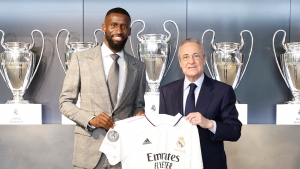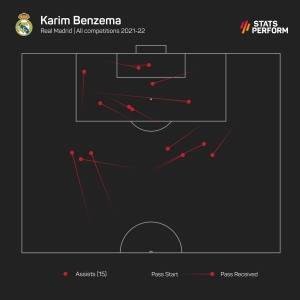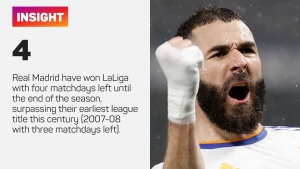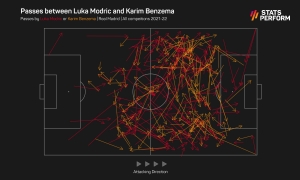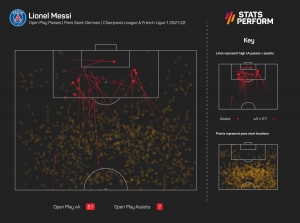Despite wrapping up their 35th LaLiga title and retaining a chance of winning the Champions League this term, Real Madrid find themselves at something of a crossroads.
The individual brilliance of Karim Benzema and Vinicius Junior may have fired Los Blancos to a dominant triumph in LaLiga, but attention will soon turn to Madrid's attempts to defend the title for the first time since 2007-08.
With the potential arrival of a true global superstar and one of the Premier League's best defenders, as well as the matter of refreshing a brilliant but ageing midfield, it promises to be an interesting few months at the Santiago Bernabeu.
Here, Stats Perform analyses what Carlo Ancelotti's men could do to fend off the potential challenge of an improved Barcelona next season.
The Mbappe conundrum: How would the superstar fit in?
For months, if not years, Real Madrid's plans for 2022 seem to have revolved around one name: Kylian Mbappe.
While recent reports have suggested the 23-year-old could yet remain at the Parc des Princes, a move for the talismanic attacker – who will be a free agent in June – cannot yet be ruled out.
Having scored 35 goals and provided 19 assists in 43 appearances in all competitions for Paris Saint-Germain, Mbappe would clearly be an asset to any team in European football, but the question remains as to how Mbappe will complement another free-scoring Frenchman in the Spanish capital.
Benzema has become just the fifth Madrid player in history to score 40+ goals in a single season for the club (after Cristiano Ronaldo, Ferenc Puskas, Alfredo Di Stefano and Hugo Sanchez), and is being touted for the Ballon d'Or after driving Madrid's Champions League run. Benzema has scored 14 goals in 10 European appearances this term, averaging a goal every 65.1 minutes in a stunning campaign.
Mbappe and Benzema are no strangers to playing together, but the PSG forward failed to score and only provided one assist when doing so during France's disappointing Euro 2020 campaign. The Madrid man, meanwhile, finished just one goal short of the golden boot after netting four times.
Matters are complicated further when taking into account the form of Vinicius, who has formed a lethal partnership with Benzema this season, registering 33 goal involvements of his own in all competitions (18 goals, 15 assists), and Mbappe's preference to play from the left could infringe on Vinicius.
However, Mbappe's development into a more well-rounded attacking talent should ensure he at least provides a threat, whichever flank he starts from.
As well as improving on his 11 assists from last season, Mbappe has completed more dribbles (138) at a higher success rate (50.74 per cent) than Vinicius this term (130, 41.4 per cent), and could join him in playing a more creative role supporting Benzema.
Upgrading in defence: The arrival of Antonio Rudiger
Having announced his intention to leave Chelsea at the end of his contract, Antonio Rudiger is another player strongly linked with a move to the Bernabeu ahead of next season.
The German defender has been one of the Blues' outstanding players under Thomas Tuchel, starring in their Champions League triumph last year and enjoying another fine campaign this season.
Rudiger has been a key component in the Premier League's third-best defence this season, with Chelsea keeping 15 clean sheets and conceding just 28 goals despite falling out of title contention after a promising start.
The 29-year-old appears to be an upgrade on Madrid's current defensive options after last year's departures of Sergio Ramos and Raphael Varane, offering more physicality than David Alaba and greater defensive steel than Eder Militao, a partnership that was frequently exposed by Manchester City recently.
Rudiger would also offer a threat at the other end of the pitch, with his three league goals this season bettered by just one other Premier League centre-back (Jan Bednarek, four), and his ability to step out of defence was on display when he scored a 39-yard stunner against Brentford in early April – Chelsea's longest-range Premier League goal since January 2007
However, Rudiger has been accustomed to playing in a back three at Chelsea and would be most likely to play as a right-sided centre-back in a back four for Madrid, unless Ancelotti opts to shift Alaba to left-back.
Rudiger would likely have to curb his attacking enthusiasm if paired with the naturally forward-thinking Alaba, but he appears a smart choice to further solidify a defence that has been the second-strongest in LaLiga this term (only Sevilla have conceded fewer goals).
The case for Camavinga: Time to look to the future?
The midfield trio of Casemiro, Toni Kroos and Luka Modric will go down in Madrid history: they started together in three consecutive Champions League final wins between 2016 and 2018, with the Croatian also starring in 2014's victory.
Nobody can question their quality or longevity. All three have made at least 35 starts this season, while Modric in particular has produced several sumptuous contributions in big games that have helped him to an assist haul of nine, six more than any other Madrid midfielder.
However, given they occasionally appear to lack a certain dynamism when out of possession, could Madrid benefit from some extra mobility in the engine room?
The signing of Eduardo Camavinga, who has made 35 appearances this term, was clearly made with such a move in mind, but the French youngster has only started 14 times in all competitions and would benefit from more playing time next season as he looks to improve his all-round game.
However, neither Camavinga nor Federico Valverde possess the kind of metronomic abilities of Modric or Kroos, and the younger pair also average fewer passes into the final third per 90 minutes than their more experienced peers (6.25 and 6.1, respectively).
As such, with the rumoured arrivals of Mbappe and Rudiger involving no transfer fees, Madrid could yet benefit from dipping into the market to acquire another young, progressive midfielder in a move that might also help to prolong the excellence of Modric and Kroos.

























